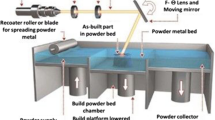Abstract
This paper established three micro-cutting simulation models for SiCp/Al composites with a volume fraction of 45%. The three models of SiCp/Al composites, established by ABAQUS software, are equivalent homogeneous model, multiphase mixture model, and multiphase mixture cohesive model. And the three models were compared and analyzed. The results showed that the equivalent homogeneous model was suitable for studying the change of cutting force, stress flow, and cutting temperature with different cutting parameters. The multiphase mixture model could simulate the material removal during machining process and the prediction of machining surface defects. The multiphase mixture cohesive model, improved on the basis of the microscopic model, could better simulate the stress transfer and the debonding of SiC particles during machining process ensuring that the simulation results become more reasonable.



















Similar content being viewed by others
References
Li Z, Hou S (2017) Research progresses in cutting SiC reinforced aluminum matrix composite[J]. Tool Eng 51(1):9–12
Zha H, Feng P, Zhang J (2017) An experimental study on rotary ultrasonic machining of high volume fraction silicon carbide-reinforced aluminum matrix composites (SiCp/Al)[J]. J Mech Eng 53(19):107–113
Wu Y (2017) Research on the cutting simulation of SiCp/Al composite and experimental verification[D]. Harbin Institute of Technology
Tang D, Zhang W, Zhao R, Lv X (2017) Machining of SiCp/Al composites: effect of tool corner radius on residual stresses, cutting force and temperature[J]. Adv Mater Res 1142:265–270
Li Q, Li K, Li H (2016) Simulation and study on the formation mechanism of chip based on micro cutting[J]. Key Eng Mater 679:103–106
Ren W, Xu J, Lin J, Yu Z, Yu P, Lian Z, Yu H (2019) Research on homogenization and surface morphology of Ti-6Al-4V alloy by longitudinal-torsional coupled ultrasonic vibration ball-end milling[J]. Int J Adv Manuf Technol 104:301–313
Zhang J, Zhang X, Wang Q, Xiao B, Ma Z (2018) Simulation of anisotropic load transfer and stress distribution in SiCp/Al composites subjected to tensile loading[J]. Mech Mater 122:96–103
Zhou L, Cui C, Zhang P, Ma Z (2016) Finite element and experimental analysis of machinability during machining of high-volume fraction SiCp/Al composites[J]. Int J Adv Manuf Technol 91:1–10
Wang B, Xie L, Wang X, Chen X (2014) Simulation studies of the cutting process on SiCp/Al composites with different volume fraction of reinforced SiC particles[J]. Mater Sci Forum 800-801:321–326
Wang B, Xie L, Chen X (2016) The milling simulation and experimental research on high volume fraction of SiCp/Al[J]. Int J Adv Manuf Technol 82(5–8):809–816
Liu J, Cheng K, Ding H, Chen S, Zhao L (2016) An investigation of surface defect formation in micro milling the 45% SiCp/Al composite[J]. Procedia Cirp 45:211–214
Dandekar CR, Shin YC (2009) Multi-step 3-D finite element modeling of subsurface damage in machining particulate reinforced metal matrix composites[J]. Compos Part A Appl Sci Manuf 40(8):1231–1239
Umer U, Ashfaq M, Qudeiri J, Hussein H, Danish S, Al-Ahmari A (2015) Modeling machining of particle-reinforced aluminum-based metal matrix composites using cohesive zone elements[J]. Int J Adv Manuf Technol 78(5–8):1171–1179
Johnson G, Cook W (1985) Fracture character theistic of three metals[J]. Eng Fract Mech 21(1):31–48
Dandekar C, Shin Y (2011) Molecular dynamics based cohesive zone law for describing Al–SiC interface mechanics[J]. Compos Part A Appl Sci Manuf 42(4):355–363
Funding
This work is supported by the Jilin Province Key Scientific and Technological Project (No.20180201057GX), Jilin Province Scientific and Technological Development Program (No.20190101005JH), and the “111” Project of China (No.D17017).
Author information
Authors and Affiliations
Corresponding authors
Additional information
Publisher’s note
Springer Nature remains neutral with regard to jurisdictional claims in published maps and institutional affiliations.
Rights and permissions
About this article
Cite this article
Xu, W., Yiquan, L., Jinkai, X. et al. Comparison and research on simulation models of aluminum-based silicon carbide micro-cutting. Int J Adv Manuf Technol 109, 589–605 (2020). https://doi.org/10.1007/s00170-020-05518-0
Received:
Accepted:
Published:
Issue Date:
DOI: https://doi.org/10.1007/s00170-020-05518-0




